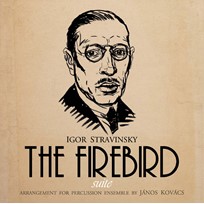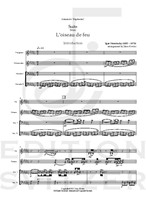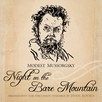
The Firebird (Suite)
Composer: Igor Stravinsky
Instrument: Percussion Ensemble
Level: Advanced
Published: 2013
Price: €60.00
Item details
-
Description +
-
Arranged by János Kovács
Duration: 25 min.
Igor Stravinsky (1882 - 1971), ground-breaking Russian composer, musical revolutionary and stylistic chameleon, was practically unknown when in 1909 influential impresario Sergei Diaghilev hired him to compose the music for a new project called The Firebird. Diaghilev, whose Ballets Russes company was already a huge success, wanted to stage a fresh, daring and distinctly 20th century style large scale ballet show to further impress the Parisian audience.
The storyline of the show was already conceived long before Stravinsky was recruited to write the score, by Diaghilev's collaborator Alexandre Benois, a key figure in modern ballet and stage-design, who combined two Russian folk-tales, The Firebird and Kashchei the Immortal, into one plot.
As with many folk-tales, the main theme of The Firebird is the initiatic journey and battle between Good and Evil. The protagonist, Prince Ivan, has to travel through the magical kingdom of Kashchei the Immortal. Here he meets and captures a supernatural creature called the Firebird, who promises to help him on his journey in exchange for its freedom. Prince Ivan then meets thirteen princesses and falls in love with one of them. He challenges Kashchei so he can win the princess' hand. Kashchei sends many magical minions to defeat Ivan but the Firebird, honoring its promise, casts a spell and forces them into a trance-like "Infernal Dance", after which they fall asleep. Kashchei is also bewitched into a dance, and meanwhile the Firebird tells Ivan what he must do in order to defeat him. Ivan finds and destroys an egg in which Kashchei has hidden his soul, thus killing him and breaking all his spells. In the end, Good prevails and everyone rejoices.
To complement this story, Stravinsky composed an innovative and dazzling score that, together with the futuristic stage design by Alexander Golovine, costumes by Leon Bakst and the impressive choreography by Michel Fokine, produced a kind of performance that had never been seen before. It was truly one of the starting points and key moments of Modernism.
After its premiere in Paris on the 25th of June 1910, The Firebird met rave reviews and ecstatic success, and transformed Stravinsky into a star. He subsequently collaborated with the Ballets Russes on two more occasions, writing the score for Petrushka in 1911 and The Rite of Spring in 1931. He went on to become one of music's most important figures.
The Firebird has been restaged many times since, well into the 21st century, proving Stravinsky's visionary genius and timeless appeal.
Amália Kovács
Târgu Mures, April 2013
-
-
Instrumentation +
-
Percussion Ensemble:
1 Vibraphone
1 Xylorimba (or Xylophone)
2 Marimbas
-
-
Watch+
-
About the composer +
-
Igor Fyodorovich Stravinsky (17 June [O.S. 5 June] 1882 – 6 April 1971) was a Russian (and later, a naturalized French and American) composer, pianist and conductor. He is widely considered one of the most important and influential composers of the 20th century.
Stravinsky's compositional career was notable for its stylistic diversity. He first achieved international fame with three ballets commissioned by the impresario Sergei Diaghilev and first performed in Paris by Diaghilev's Ballets Russes: The Firebird (1910), Petrushka (1911) and The Rite of Spring (1913). The last of these transformed the way in which subsequent composers thought about rhythmic structure and was largely responsible for Stravinsky's enduring reputation as a musical revolutionary who pushed the boundaries of musical design. His "Russian phase" which continued with works such as Renard, The Soldier's Tale and Les Noces, was followed in the 1920s by a period in which he turned to neoclassical music. The works from this period tended to make use of traditional musical forms (concerto grosso, fugue and symphony), drawing on earlier styles, especially from the 18th century. In the 1950s, Stravinsky adopted serial procedures. His compositions of this period shared traits with examples of his earlier output: rhythmic energy, the construction of extended melodic ideas out of a few two- or three-note cells and clarity of form, and of instrumentation.
-
-
Reviews +
-
To come
-
-
Credits +
-
Front Cover graphics and layout: Amália Kovács
Engraving: János Kovács & Johan Svitzer
Preface: Amália Kovács
Translation: Amália Kovács
Printed in Copenhagen, Denmark
Copyright © Edition SVITZER
www.editionsvitzer.com
-


